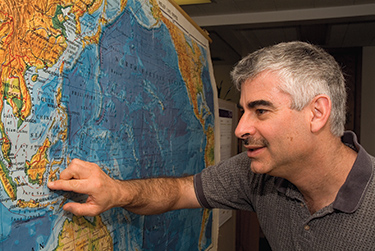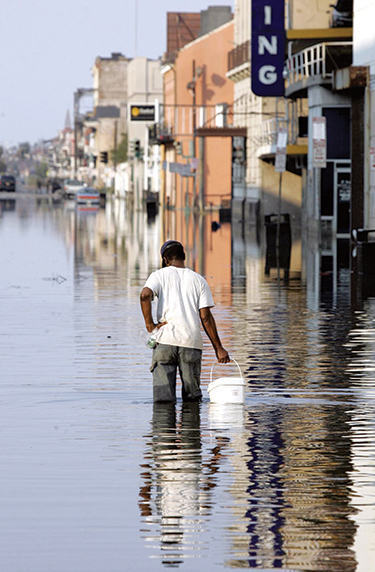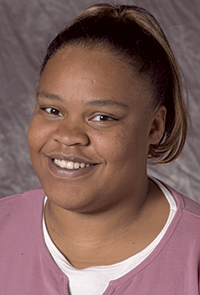Mark Haselkorn is not in a good mood. It’s September 1, the water is still rising in New Orleans, and the Hurricane Katrina relief effort is an unmitigated failure.
“Once again, we’re four days into the thing and it’s communication problems, it’s “who’s in charge?’ ” Haselkorn says. “You know, you’d think it’s our country and FEMA would have everything under control. They don’t.”
The failure offends him at several levels. As a human being, he’s aghast at the suffering. As a professor of technical communication in the College of Engineering and a former resident of the French Quarter, he resents the mismanagement all the more bitterly and feels the loss all the more personally. And as the founding director of the University of Washington’s new Interdisciplinary Program in Humanitarian Relief (IPHR), he’s frustrated for yet another reason — the way nations deal with disasters, which is to wait until they happen and then throw money at them.
It’s a risky subject to raise, as Elizabeth Kolbert pointed out in the New Yorker, because to most Americans “a disaster of [Katrina’s] magnitude seems to demand not dispassionate analysis but simple human empathy.” But according to Haselkorn, a dose of dispassionate analysis is just what the conversation needs. “The disaster-response organizations are going to get plenty of money. They won’t even be able to spend it all. Same thing happened with the tsunami. I can’t tell you the phenomenal amount of tsunami money that has yet to be spent. And that’s not to take away from the heroic effort that’s going on. It is heroic. It is necessary. It’s just that there’s a role for researchers, a role for thinkers as well as doers, in this sector,” he says.
The University of Washington may now be thinking, and doing, more about the need for improved humanitarian relief efforts than any other academic institution, thanks to Haselkorn and a group of like-minded scholars from a remarkably diverse range of disciplines. Through the new interdisciplinary program — a collaboration among the Marc Lindenberg Center in the Evans School of Public Affairs, the College of Engineering, and the Center for Internet Studies — they’re trying to change the way people prepare for and respond to disasters. It is the first of its kind in the nation.
“The fact is those people wouldn’t be on the roof if the universities were doing a better job of doing research, and if the whole world thought about research as part of the humanitarian activity.”
Mark Haselkorn, director of the Interdisciplinary Program in Humanitarian Relief
“We need to play our role as a university,” Haselkorn says, “to get the research done, to professionalize the field, to think about systems, to think long-term. Because everybody else, as expected, is worried about those people on the roof. And they should be. But the fact is those people wouldn’t be on the roof if the universities were doing a better job of doing research, and if the whole world thought about research as part of the humanitarian activity. That’s my soapbox.”
Hindsight may be 20/20, but Haselkorn was on his soapbox long before New Orleanians were on their roofs. In late 2003 he began having conversations with Elaine Chang, then acting director of the Lindenberg Center, about ways in which engineering and humanitarian relief might be synthesized in a program of academic study. The following spring, he taught the University’s first-ever course on “Humanitarian Logistics.” A few months later, he and three colleagues co-wrote a proposal for “a new interdisciplinary program in humanitarian relief at the University of Washington,” citing “a self-acknowledged lack of professionalization” in the field. And in January, just after the tsunami devastated South Asia, Haselkorn published an op-ed piece in the Seattle Times in which he noted that the emergency management sector “reinvents itself with each new catastrophe.” From where he stands, the bungled responses to Katrina — symbolized by the image of hundreds of unused, half-submerged school buses — and, more recently, the earthquake in Pakistan, are “terrible ways of being proven right.”

Professor Mark Haselkorn. Photo by Mary Levin.
The lack of professionalism, Haselkorn adds, has nothing to do with a lack of professionals. On the contrary, humanitarian relief attracts extraordinarily hard-working, resourceful people. But there’s no degree that credentials them, as he pointed out in his Times article, “or journal devoted to research on improving humanitarian-relief systems. Field workers learn on the job and there is a turnover rate of nearly 80 percent per year” in the non-governmental organizations, leaving few veterans to mentor the newcomers.
The program intends to remedy some of that, beginning with the professional credential. As of this past fall, the UW is offering what may be the field’s first frame-worthy piece of paper — a certificate in relief. It’s a one-year program, which students from a wide variety of disciplines can complete while working toward their advanced degrees. Along with some core courses in systems and logistics, the requirements include a substantial “practicum” — several weeks of hands-on relief work.
Randy Kemp, an Information School Ph.D. candidate, will be part of the first wave of 31 students to receive the certificate, although he may have trouble finding a place for it on his wall — he already holds degrees in international relations, information library studies and Christian studies. Kemp says he hopes to spend his practicum in the Middle East or North Africa, studying the feasibility of a user-friendly Geographic Information System (GIS) device for recovery efforts. GIS technology is a sort of “intelligent mapping,” often derived from satellite imagery, that links data to location. Though the device exists only in Kemp’s imagination, it has clearly been there for a while now.
“It would have to involve a global positioning system,” he says. “Then there’d be some kind of computer system, whether it’s a small thing, like the size of a PDA [personal digital assistant], or a full-blown laptop that’s totally bomb-proof. And a digital camera to take pictures, which can then be associated with the data that’s collected at that location.”
Kemp may find that the biggest challenge he faces isn’t getting his device built, but getting it used. According to Glenn Brooks, manager of a new geographic information data center at the UW, relief groups tend to be “technology-averse organizations, for many reasons — cost, technophobia, inability to run a computer in the desert.” It’s a sad irony, he says, that “the one discipline where GIS could be most effective is the one where it’s least received.”

Thousands died in the Oct. 8 earthquake that struck Pakistan, India and Afghanistan, including residents of this housing complex inIslamabad, Pakistan.
But, he adds, “I do see that changing.”
Brooks is seated in what was once the living room of a creaky, tan 1920s bungalow on N.E. 12th Ave., just across from Condon Hall. The property is owned by the UW and administered by the Evans School, and for the past year has been the headquarters of a low-budget, high-tech data lab. Mercy Corps, a humanitarian nonprofit based in Seattle, donated eight computers and a one-terabyte file server, all equipped for GIS and remote-sensing work, and Brooks bought office furniture from Boeing surplus.
“These are three-dollar chairs,” he says. “Everything in the building we bought for a hundred dollars.”
It’s hard to imagine anything of global significance happening in such a space. But the lab and its resident, all-volunteer organization, the Pacific Northwest GIS Response Team, were major players in the tsunami recovery effort, and are now up to their elbows in the Katrina cleanup.
Brooks, a soft-spoken man of about 60, has a longstanding interest in making disaster relief more efficient. He grew up in Alaska, and got his first taste of recovery work in 1964, rebuilding bridges and rail lines after the Great Earthquake and the tsunami waves it spawned. Later, he served as chief of police for the University of Alaska, where “a good portion of the job was disaster response — earthquakes, volcanoes, wind storms,” he says. “I used to do all this, what we now call GIS stuff, using butcher paper and marking pencils to track serial offenders. I sometimes think I was born 25 years too early.” He earned his professional certificate in GIS from the UW Extension in 1999, and for the past several years has been trying to introduce the technology to the disaster response field.
Not long after the 2004 tsunami hit, Brooks checked in with a friend at the Pacific Disaster Center in Hawaii. The staff was overwhelmed by the scale of the tsunami’s destruction and wanted help processing satellite images. Brooks, who at the time was doing GIS work for Mercy Corps, agreed to take on some of the center’s load.
But he needed a facility. He contacted the UW in early January, and his request quickly came to the attention of Elaine Chang and Evans School Dean Sandra Archibald. They saw that it was not only a compelling cause, but one that dovetailed beautifully with the goals of the new Interdisciplinary Program in Humanitarian Relief. Brooks recalls having access to a temporary GIS facility “in a matter of days,” and being offered the bungalow just a few weeks later. He and a team of about 50 volunteers spent the next several months converting satellite images to PC format and sending them back to the disaster center, which then posted them on its Internet map server.
“The purpose,” Brooks says, “was to use remote sensing to show the before-and-after picture.” He produces an 11-by-14 sheet of paper with two views of coastal Banda Aceh, Indonesia. They’re similar, but the one on the right looks as though it has been scrubbed with steel wool. “This is the day of the tsunami,” Brooks says. “There happened to be a satellite in the area. So you can see the differences, in terms of coastal erosion. And all these scattered white splotches are actually the cement pads where houses used to stand.”
In the following months, about 20 UW student volunteers joined what had become the Pacific Northwest GIS Response Team. Brooks and the other volunteers trained them and put them to work. “The student group was very instrumental in helping us do some follow-up mapping,” he says, “both of Sumatra and of Sri Lanka. We digitized about 2,000 house locations off of satellite imagery.”
The new interdisciplinary program is trying to change the way people prepare for and respond to disasters. It is the first of its kind in the nation.
When Katrina came along, the team looked homeward. Brooks and his volunteers began compiling what they call the Katrina Disaster Atlas — an electronic archive of interrelated maps that describe the storm and its myriad effects, from flooding to wind speed to economic impact and population displacement.
In mid-September, Brooks sent the atlas to Mississippi with a delegation from the Seattle chapter of the American Institute of Architects, which had been asked to help do damage assessment. The architects spent a week posting color-coded placards on public buildings — green, yellow or red, depending on the probable safety of each structure. Rachel Minnery, a member of the group, says that the atlas’s wind map was particularly useful. “You could definitely see Katrina’s path, and which buildings were damaged and which were not,” she says. “I think there’s a lot to be learned from what GIS has to offer.”
While she was down there, Minnery says, she spent more time than she would have liked in her car, studying street maps on her laptop. Told of the fieldworker-friendly device that Randy Kemp hopes to design, she suggested an additional feature. “A compass would’ve been extremely helpful,” she says. “Because after a hurricane, you don’t have street signs, and your landmarks are half-destroyed. Even people that were familiar with the area had a really hard time navigating.”

A New Orleans resident wades through the floodwaters on Canal Street.
In the coming months, Brooks and his volunteers will also be furnishing maps to teams of researchers from throughout the University — the recipients of small grants from the National Science Foundation. Immediately after Katrina, the foundation set aside some money for hurricane-related research to quickly capture valuable “ephemeral data.” The guidelines made it clear that only multidisciplinary proposals would be considered.
Haselkorn saw this as an opportunity for the new humanitarian-relief program and convened two brainstorming sessions in early September. He also set up a list serve to help bring research teams together. Professors began posting their calls for collaborators; some simply offered their services: “I would be interested in working with you to any degree possible on the ethical, legal and health policy issues.” “My area of expertise is affordable housing policy in the U.S.” “My individual research interest is in coastal and nearshore ecosystem restoration.”
What emerged was a package of interrelated proposals covering everything from those half-submerged school buses to disease risk to the development of hurricane-resistant housing to issues of race, safety and politics.
“It’s just amazing,” says Sanjeev Khagram, the newly appointed director of the Lindenberg Center, “to think that we have a proposal with the director of the civil engineering department as the lead principal investigator and a social work junior faculty member as one of the team. I mean, that’s just phenomenal.”
The University of Washington, says Khagram, isn’t the only place where academics are beginning to take disaster relief seriously. But it may be the only place where they’re approaching it so cooperatively. And that’s vital, he says, because humanitarian crises “are by their very nature interdisciplinary.”
“The research problem” posed by a tsunami or a Katrina, says Haselkorn, “is that data in isolation, data from a single perspective, are inherently flawed. Because it’s such an interdependent system. It doesn’t matter where you approach it from. As soon as you go in, you run into everything else.”
He recalls the first time he and an engineering colleague met with Elaine Chang at the Evans School to discuss humanitarian relief. “It was just this instant realization,” he says, “on everyone’s part: “Of course, you need these multiple perspectives. Of course you can’t do this alone.”
Student finds higher ground at the UW

Charmain Chatman
When the water in the living room reached her waist, Charmain Chatman told her four-year-old son, Jaleal, that it was time to play a game. The object was to get to the highest spot in the house. His Uncle William was going to help him up through a little door in the wall. Then his Uncle Samuel was going to carry him, stepping-stone-wise, across the attic’s beams to a slatted section of floor where they could stand.
“You could see that he was nervous,” Chatman says. “But I think it just reassured him to play along.”
As a single mother working her way through college, Chatman knows a thing or two about grace under pressure. But she’d never dealt with anything quite like Hurricane Katrina, which filled her father’s Biloxi, Miss., house with five feet of water and rolled the tin sheets on its roof into curlicues. It destroyed most of her belongings, closed the University of Southern Mississippi’s Gulf Park campus two days into her senior year, and generally brought her life to a standstill.
Thankfully, in the weeks since, Chatman has had some help getting to higher ground. She’s one of 92 hurricane-displaced men and women whom the UW has taken in as non-matriculated exchange students. That means that whatever tuition money they pay will stay with their home institution. The University has also set up a Katrina Student Resource Center in Mary Gates Hall, to help the new arrivals handle the practical details of relocation.
And Chatman has had other guardian angels. A group of her mother’s high school classmates paid for her plane ticket to Seattle, and a local business put her up in an apartment near campus with cable and a phone. She arrived the Sunday before classes were to start and signed up for in the ones she needed to keep her biology major on track — physics, cellular physiology and the history of science. Slowly, she says, a sense of normality is returning to her life.
Jaleal, meanwhile, seems to have taken it all in stride. He’s going to school at the Children’s Center in Laurel Village, and is cheerily telling his story to anyone who will listen.
“With everybody that we meet on the street, he’s like, ‘Hey, how are you doing? A hurricane was at my house,’ ” Chatman says. “So I’m constantly explaining. And I’m constantly telling him, “You know, Jaleal, you don’t always have to say that.’ ”